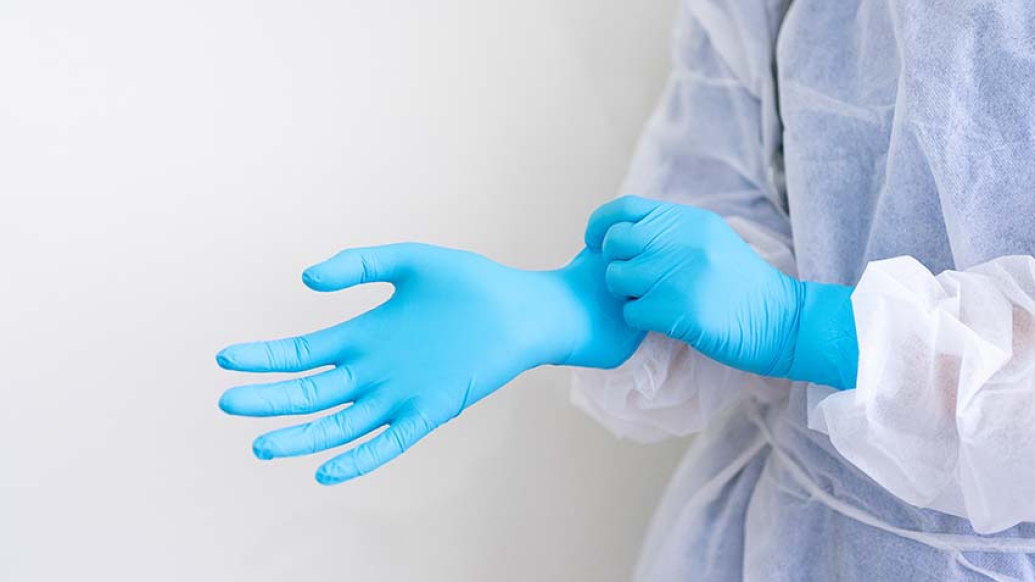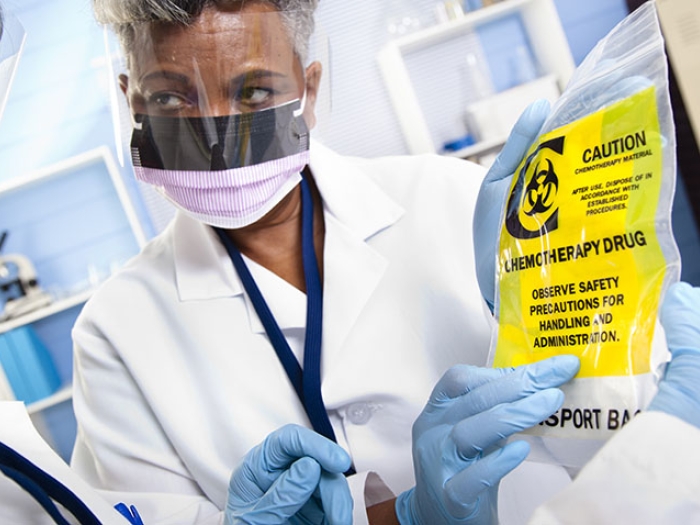With no national data source, a U-M-led study has uncovered frequent spills, inconsistent PPE use and problems with closed-system transfer devices across 12 institutions.
5:00 AM
Author |

While lifesaving to cancer patients, chemotherapy drugs can be hazardous for the health care workers who handle them, especially during a spill.
Inconsistent use of personal protective equipment when cleaning up a spill and problems with closed-system transfer devices — which are designed to prevent the release of toxic vapors and liquids — topped issues uncovered by a University of Michigan Rogel Cancer Center-led safety study involving nearly 400 nurses across 12 academic infusion centers.
The findings, which appear in the Clinical Journal of Oncology Nursing, highlight the need to improve reporting and training, and for additional research into the underlying causes of hazardous spills, the authors say.
"Our data show that there were more spills happening than might be expected and when they happen, nurses are often not following best practices to protect themselves from hazardous chemicals exposure," says lead study author Christopher R. Friese, Ph.D., R.N., Elizabeth Tone Hosmer Professor of Nursing and a professor of health management and policy at U-M. "There's no national database for these type of spills, like there is for needle sticks, and our survey is a snapshot that points to a serious, widespread problem."
Friese calls chemotherapy exposure an "invisible threat." Health care workers can be exposed when they inhale chemical vapors or touch contaminated surfaces. Studies have found that nurses who reported handling hazardous drugs had twice the risk of reproductive problems. Other studies report incidences of rare cancers and various respiratory and skin conditions resulting from exposure.
The spill analysis was part of a continuing examination of data collected through a study called the Drug Exposure Feedback and Education for Nurses' Safety, which launched in March 2015. Previously published work from the study explored efforts to increase the use of personal protective equipment.
In the new article, nurses at the 12 participating, high-volume ambulatory infusion centers reported 61 spills over the two-year study period. Only one facility reported zero spills, while one location reported 10.
Collectively, the reports revealed:
-
More than 65% of the spills occurred despite the use of a closed-system transfer device. And those devices reportedly didn't function properly at least half of the time.
-
Recommended protective gear was only used a fraction of the time. Nurses donned two pairs of chemotherapy-rated gloves in 40% of the incidents. They wore a respirator, such as an N95 mask, in 30% of cases, and eye protection 20% of the time.
-
11 of the incidents involved skin contact with a hazardous drug.
"I think there's a sense in the health care community that these spills aren't happening that often," says Friese, who maintains a clinical practice in addition to his research program. "But these data show that this is a fairly common and serious threat to front-line cancer nurses."
To understand how often these spills are happening and why, hospitals and clinics will need more robust data, Friese says.
There's no national database for these types of spills, like there is for needle sticks, and our survey is a snapshot that points to a serious, widespread problem.Christopher Friese, Ph.D., R.N.
"We need to make the reporting process easy, so that this can be a learning opportunity to improve practice," he says. "It's clear there are a multitude of factors involved in why these spills are happening and why nurses aren't following guidelines meant to protect them during a clean-up."
Additionally, with the current COVID-19 pandemic putting pressure on the availability of PPE, hospitals across the country are adapting their workflows to decrease the overall use of masks and gloves and gowns, Friese notes.
MORE FROM THE LAB: Subscribe to our weekly newsletter
"But even during this challenging time, it's important that nurses still wear the full complement of PPE when responding to a hazardous spill," he adds. "Their future health may depend on it."
Two years ago, U-M, through the support of the National Cancer Institute, developed a one day safety workshop for oncology nurses and pharmacists that includes training on handling hazardous drugs.
The study was supported by the National Institute for Occupational Safety and Health (R01OH010582), U-M Center for Occupational Health and Safety Engineering (T42OH008455), the Rita and Alex Hillman Foundation, the Jonas Nurse Scholars Program and the American Cancer Society.
Additional authors on the paper include Mandy Wong of Northwestern University; Alex Fauer, Kari Mendelsohn-Victor and Marjorie C. McCullagh of U-M; and Martha Polovich of Georgia State University.
Paper cited: "Hazardous Drug Exposure Case report analysis from a prospective, multisite study of oncology nurses' exposure in ambulatory settings," Clinical Journal of Oncology Nursing. DOI: 10.1188/20.cjon.249-255
Like Podcasts? Add the Michigan Medicine News Break to your Alexa-enabled device or subscribe for updates on iTunes, Google Play and Stitcher

Explore a variety of healthcare news & stories by visiting the Health Lab home page for more articles.

Department of Communication at Michigan Medicine
Want top health & research news weekly? Sign up for Health Lab’s newsletters today!





